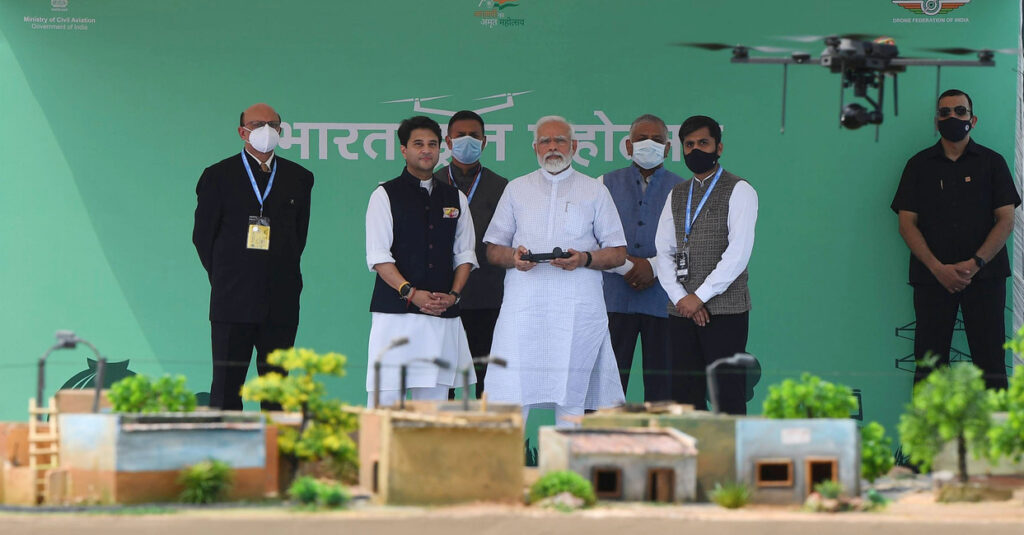
Prime Minister Narendra Modi, at the inauguration of the Bharat Drone Mahotsav, laid out his vision to make India the global drone hub
The Indian drone sector is poised for a great leap forward following the liberalisation of regulations in 2021. Consistency in regulatory framework, government support, and private investment can help India become a global player in one of the fastest growing segments worldwide
Both Russia and Ukraine are producing a million plus small drones that can be quickly deployed on the frontlines. Most of these one-way attack drones are 3D-printed, which has lowered the cost of serial production to $200-$500, depending on the features and range, making them 10 to 50 times cheaper compared to guided artillery shells
Drones are increasingly becoming ubiquitous for their sheer versatility. From the rudimentary pilotless aircraft, Kettering Bug, that was developed during World War I to the current generation of Unmanned Aerial Vehicles (UAVs), commonly called drones, they have become increasingly equipped with sophisticated software and the ability to operate way beyond the visual range for performing a variety of tasks.
Once relegated to just military applications like surveillance and reconnaissance, drones are now more accessible and have become indispensable across a wide range of civilian sectors. Their ability to operate in difficult terrain, provide high-resolution data in real time and execute tasks autonomously is transforming sectors such as agriculture, energy, infrastructure and logistics. With a projected global market size of $102.38 billion by 2030, up from $22.68 billion in 2021, and a robust compound annual growth rate (CAGR) of 18.2% between 2021 and 2030, the sector represents both the pace of technological evolution and market adoption.
Drones In Modern Warfare
The extent and pace at which low-cost UAVs have proliferated in the battlefield is astounding. Until the Russia-Ukraine war that started with the invasion of Ukraine in February 2022, drone warfare was commanded by closely guarded technology platforms.
Over the past decade, countries such as the US, UK, Israel, China,
Norway, Turkey, and Iran, among others, developed advanced drone programmes for military use. But, for the first time, the Russia-Ukraine war saw widespread use of cheap commercial off the shelf (COTS) drones being repurposed for use in the battlefield with devastating effect, especially against armoured and infantry formations. The latest in the line of this rapid evolution is the largescale use of fast and weaponised First Person View (FPV) drones.
Both Russia and Ukraine are producing a million-plus small drones that can be quickly deployed on the frontlines. Most of these one-way attack drones are 3D-printed, which has lowered the cost of serial production to $200-$500, depending on the features and
range, making them 10 to 50 times cheaper compared to guided artillery shells. The latest innovation is optic fibre-guided drones, which are impervious to electronic jamming—an area in which the Russians still enjoy the upper hand. Besides UAVs, Ukrainians have deployed Unmanned Sea Vehicles (USVs) to devastating effect that has played a huge role in evicting the formidable Black Sea Fleet from its base at Sevastopol port in Crimea. It’s now being reported that Ukraine has started deploying a large number of armed Unmanned Ground Vehicles (UGVs) against Russian infantry in several sectors of the frontline.
The most remarkable aspect is that Ukraine, which did not have a worthwhile ecosystem for the development and mass production of unmanned systems, developed it almost from ground up during the course of the war with generous help from its Western partners. Ukraine not only caught up with Russia, which had developed a complete range of aerial unmanned systems—from surveillance platforms to an array of loitering ammunition systems—over the past decade, it has managed to surpass its superior enemy in both sea and land domains.
More recently, Ukraine unveiled three long-range missile-drones—Palianytsia, Pkelo, and Ruta—that combine the features of missiles and UAVs and are powered by turbojet engines with effective range varying from 700 km to 2,000 km. According to Ukrainian officials, this class of UAVs is faster, reaching speeds
up to 700 km/hr and can carry heavier explosive payloads. They
have also claimed that Palianytsia and Pkelo have already been used against Russian targets in the war, while Ruta is in the final
phase of development. In September, Palianytsia missile-drone was used to strike two ammunition depots in the western Russian town of Toropets, about 500 km from the Ukrainian border, blowing up almost 2,000 tonnes of ammunitions.
The most remarkable aspect of the Ukrainian drone programme is the speed of development and their deployment in the war. From concept to serial production, utilising modern manufacturing methods like 3D printing has not only drastically reduced the cost of production but has also significantly increased output amid an ongoing war.
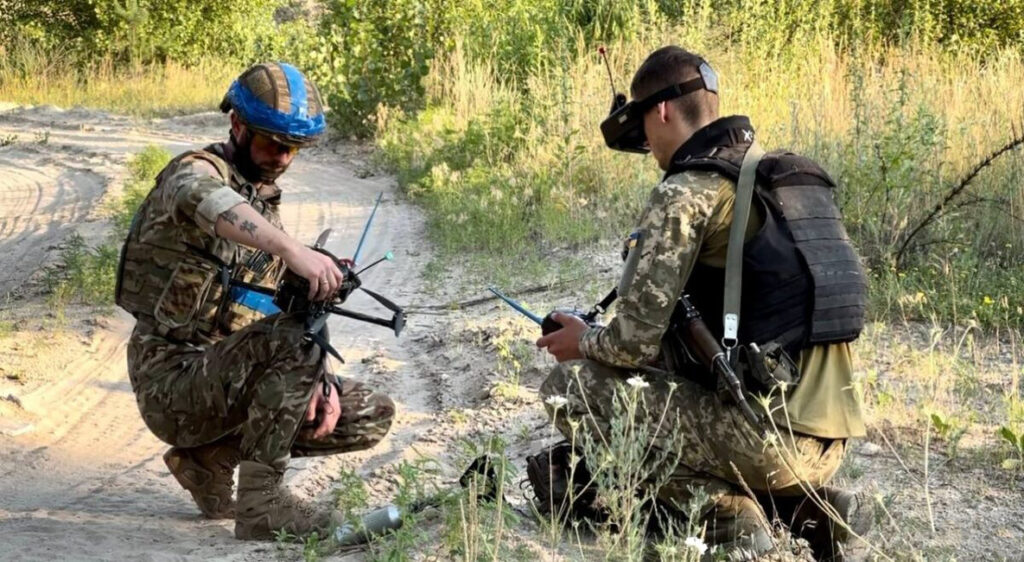
Both Russia and Ukraine are producing over a million drones annually for the war’s needs
These battlefield developments have been noted by the Indian armed forces.
According to news reports, India is investing Rs 3,000-Rs 3,500 crore in the manufacture and procurement of a range of military drones. But lessons from Ukraine show that India needs to invest heavily in research and development and manufacturing that is
flexible enough for servicing the needs of both the civilian and military sectors. At the same time, there is an urgent need to invest in an array of electronic warfare (EW) countermeasures as no single EW system can deal with the wide range of drones used in the battlefield.
Drones In Civilian Sector
Drones are already used for accomplishing a wide range of tasks in the civilian sector.
From agriculture to media and entertainment, from disaster monitoring to delivery of relief material, from surveillance for maintaining law and order to surveying critical infrastructure, the list of use cases is ever expanding as hardware, sensors, and software continue to evolve.
In the agriculture sector, drones are being used for crop spraying and seeding, reducing dependence on the erratic supply of farm labour. The government’s initiatives, like the Drone Shakti programme and Kisan Drones scheme, along with subsidies and contingency fund make the technology more accessible. Equipped with multispectral cameras and sensors, drones can monitor crop healthanalyse soil conditions and optimise irrigation.
Start-ups like Aarav Unmanned Systems, BharatRohan and Marut Drones The global agricultural drone market is projected to grow at a CAGR of 35.9% to reach $5.7 billion by 2025. Utilisation of drones is expected to increase India’s agricultural GDP by 1%-1.5%.
Agriculture insurance companies are relying on drones to assess crop damage over large areas efficiently for computation of compensation have introduced solutions for pesticide spraying, crop mapping and afforestation.
For instance, Marut’s drone-based afforestation initiative has planted over 50 lakh seed balls across multiple states. The global agricultural drone market is projected to grow at a CAGR of 35.9% to reach $5.7 billion by 2025. Utilisation of drones is expected to increase India’s agricultural GDP by 1%-1.5%. Agriculture insurance companies are relying on drones to assess crop damage over large areas efficiently for computation
of compensation.
The Indian government is providing extensive subsidies to promote adoption of agricultural drones. Institutions like the
Indian Council of Agricultural Research, Krishi Vigyan Kendras and State Agriculture Universities can avail of 100% subsidy (up to $10 lakh per drone) for demonstrations, while Food Processing Organisations get 75% subsidy for drone demonstrations. For hiring drones, implementing agencies are granted $6,000 per hectare, while those owning drones get Rs 3,000 per hectare for demonstrations. To facilitate rental services, cooperative societies and Food Processing Organisations are eligible for 40% subsidy (up to Rs 4 lakh per drone) and agriculture graduates establishing Custom Hiring Centres can get 50% subsidy (up to Rs 5 lakh per drone). Small and marginal farmers, SC/ST, women and Northeast farmers are eligible for 50% subsidy (up to Rs 5 lakh), while other farmers can avail of 40% subsidy (up to Rs 4 lakh).
These measures are aimed to make drone technology accessible and cost-effective for enhanced agricultural productivity.
For mapping land and infrastructure, both urban and rural, drones are proving to be an indispensable tool. The Government of India’s The Survey of Villages and Mapping with Improvised Technology in Village Area (SVAMITVA) project that was launched by Prime Minister Narendra Modi on April 24, 2020, that envisaged mapping of village land across India for digitisation of rural land records, is the largest undertaking of its kind in the world.
The global agricultural drone market is projected to grow at a CAGR of 35.9% to reach $5.7 billion by 2025. Utilisation of drones is expected to increase India’s agricultural GDP by 1%-1.5%. Agriculture insurance companies are relying on drones to assess crop damage over large areas efficiently for computation of compensation

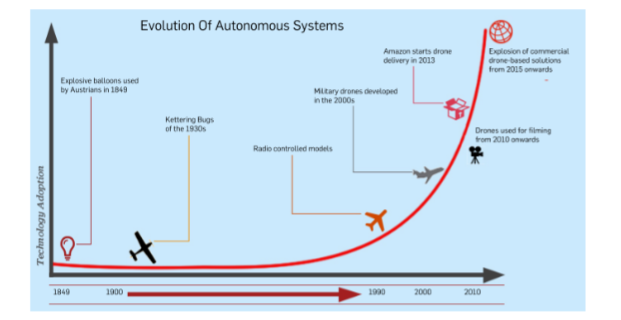
Land mapping in progress in rural Rajasthan under the SVAMITVA project that was launched in 2020
Advancements in chip technology in the 2000s led to the explosive growth of the drone sector
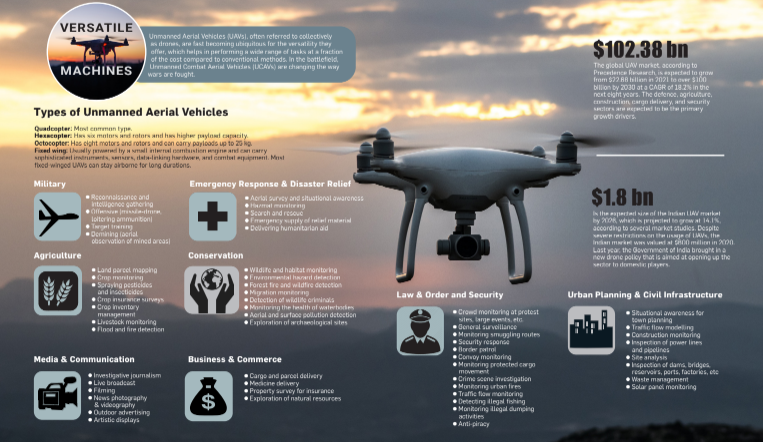
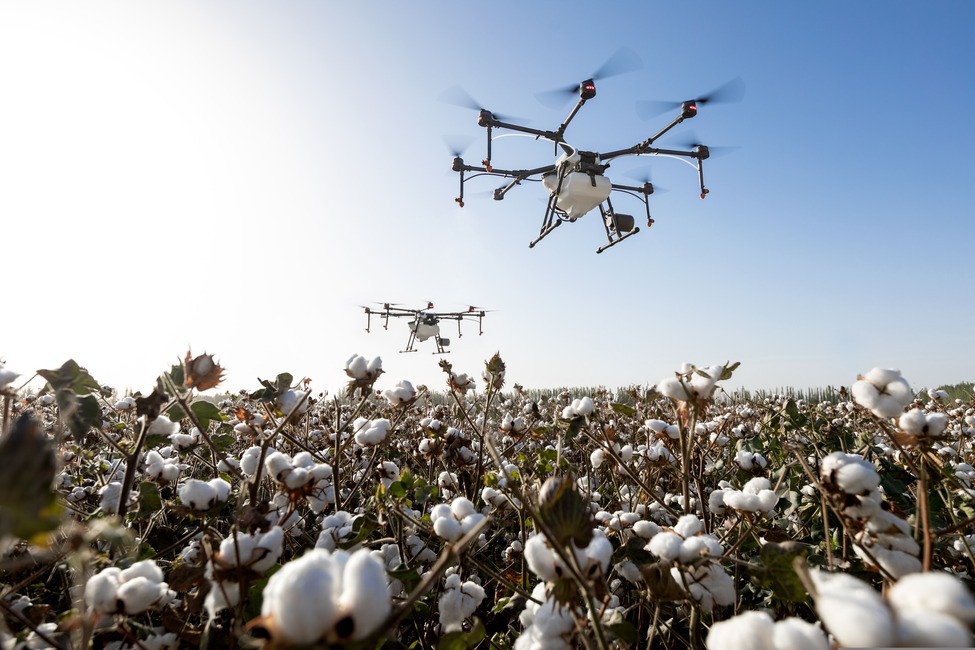
Farmers are increasingly adopting drone-based crop spraying for cost and time efficiency
The Indian Government’s Push: Policy And Programmes
The Indian government has taken several proactive steps to foster the growth of the industry. Through regulatory reforms, financial incentives and skill-development programmes, the government is creating an enabling ecosystem for innovation and adoption. “The PLI (production linked incentive) scheme for drones has been a great success, which has allowed 23 Indian companies to achieve a combined turnover of Rs 1,400 crore from an initial budget of Rs 120 crore,” said Vumlunmang Vualnam, secretary, civil aviation. According to the ministry’s website, as of December 2024, India has 26,800+ registered drones, 139 drone schools and over 11,800
certified pilots.
●Production-Linked Incentive (PLI) Scheme: Launched
in 2021 with a Rs 120 crore allocation, the scheme promotes local drone manufacturing under the Atmanirbhar Bharat initiative to make India a global drone production hub.
● Drone Shakti Scheme: Focused on start-ups, this initiative promotes drones-as-a-service (DaaS) to enhance drone penetration across various business sectors.
● Namo Drone Didi Scheme: To empower women by enabling Self-Help Groups (SHGs) to provide drone based rental services for agricultural purposes. The scheme aims to support 14,500 SHGs across India between 2024 and 2026. It offers an 80% subsidy of up to Rs 8 lakh for SHGs to purchase drones.
● Bharat Drone Mahotsav: India’s largest drone festival, inaugurated by PM Modi, showcased drones, licensing details and employment opportunities.
● Ban on Imports: The government banned drone imports (except for defence and R&D) to encourage domestic manufacturing and services for local production.
● Agricultural Schemes: Initiatives like the Kisan Drone scheme, flagged off by Modi, introduced drones for pesticide spraying along with subsidies to boost agricultural drone adoption.
● Drone Rules 2021 & Digital Sky Platform: The Rules simplify regulations for manufacturers and operators, while the Digital Sky platform facilitates licensing, approvals and flying zone guidelines. The Drone Rules 2021 marked a turning point for the industry by simplifying operational requirements. Licensing norms were relaxed and the “No Permission-No-Take-Off” (NPNT) framework (digitally, excluding Nano drones) was introduced to ensure safe and controlled usage. This regulatory clarity has given a significant boost to start-ups and businesses
venturing into the drone ecosystem.
● Drone Airspace Map: The government opened up 90% of Indian airspace as a green zone for drones flying up to 400 feet.
On December 27, 2024, Modi addressed 58 lakh village landowners virtually and issued digitised property cards for 50,000 villages in 10 states, marking the completion of the first phase of the ambitious project. Over the past two years, more than 75 lakh digital property cards have been issued.
Drones are being used for creating 3D maps of urban areas, which are vital for
developing drone-based logistics. For drones to operate in an urban environment, three dimensional spatial maps with references to vertical structures are imperative for mapping drone corridors for beyond visual line of sight (BVLOS) operations.
Start-ups like Skylark Drones and UrbanMatrix Technologies specialise in
deploying drones to capture and analyse data, offering real-time solutions for larges scale infrastructure projects like highways, bridges and urban housing.
During the Covid-19 pandemic, drones delivered vaccines and medicines to remote areas on an experimental basis. During times of natural disasters like floods and earthquakes, drones equipped with thermal cameras and advanced sensors have facilitated search-and-rescue missions, real-time damage assessments and the delivery of emergency supplies. Companies like TechEagle Innovations and Skye Air are not only redefining the logistics chain, they have also used drones to transport blood samples and medical kits across challenging terrain, reducing response times.
Use of drones by the National Disaster Response Force (NDRF) in disaster-hit areas helped in quickly developing situational awareness and designing rescue and relief missions.
The scalability of drone-based delivery systems promises to revolutionise supply chains, making goods and services more accessible to a broader population. A Punebased start-up, Enercomp Solutions, is offering drone mapping and extraction of location intelligence from aerial data services for the infrastructure sector like mapping power transmission lines, mining, earthwork calculation and bathymetric surveys of rivers and dams. Skye Air has also partnered with insurance companies for crop mapping and crop damage assessment for quicker settlement of claims.
Mining has traditionally been a labour-intensive and high-risk industry.
Drones equipped with thermal imaging sensors and terrain mapping tools enable the efficient inspection of mining sites and infrastructure, reducing risk and enhancing operational efficiency. Bengaluru-based start-up Aereo has partnered with companies like Tata Steel to offer drone mapping solutions for open-cast mining operations by providing real-time data and high-resolution imagery. Drones are helping mining companies optimise operations, improve safety and increase productivity.
Social Transformation Through Inclusion
The Government of India’s pioneering initiative, the Namo Drone Didi programme, is already having a social impact. Launched in November 2024, the government has already approved an outlay of Rs 1,262 crore as part of
its central cector scheme for providing drones to women’s Self-Help Groups (SHGs). The scheme aims to provide drones to 14,500 selected SHGs for periods from 2024-25 to 2025-2026 for providing rental services to farmers for application of liquid fertilisers and pesticides. Radha Bhatia, president, Women in Aviation India (WAI), said, “India already has the largest number of women pilots in the world. Many of these girls have never seen an aircraft or have never been exposed to the world of aviation, but now they are operating drones and earning a living.”
Revolutionising India’s Aerial Economy
According to Tracxn, India has more than 470 drone-based start-ups with each addressing unique challenges and offering solutions. Drone Rules, 2021, followed up with the Drone Rules (Amendment), 2022, liberalised the regulations considerably with the aim of setting up a vibrant ecosystem that fosters the growth of the sector. Globally, the Chinese are the most dominant players in the small and medium payload segments, which are predominantly used for commercial operations.
India’s drone industry has heightened investor interest, with funding steadily increasing over the years. Between January 2016 and November 2023, the segment secured investments of over $83 million.
According to Business Today, drone startups attracted $49.7 million in FY 2022-23, marking a threefold increase in investment over the past three years. Indian drone start-ups are also preparing to scale up globally. Companies like idea Forge, backed by prominent investors like Qualcomm Ventures, exemplify this ambition. According to Inc42, in July 2023, idea Forge Technology raised Rs 240 crore through an IPO, debuting at a 94% premium over its issue price, showcasing strong market confidence. Start-ups such as Asteria Aerospace
On December 27, 2024, Modi addressed 58 lakh village landowners virtually and issued digitised property cards for 50,000 villages in 10 states, marking the completion of the first phase of the ambitious project. Over the past two years, more than 75 lakh digital property cards have been issued under the SVAMITVA project
attracted investment from Reliance Industries, which acquired a 51% stake for
Rs 23.12 crore in December 2021. The IPO plans of firms like AVPL International signal the readiness of these start-ups to attract retail and institutional capital, further solidifying the ecosystem. Not just start-ups, even conglomerates like Tata, Reliance, Adani, etc., have entered the sector. “Eventually, drone technology will become like the infrastructure technology
that remains in the back,” says Ankit Mehta, CEO, ideaForge. Compared globally, the Indian drone sector is still in a nascent stage, but the building blocks are in place. To make India the global drone hub, as envisioned by Modi in 2021, focus should be more on research and development and manufacturing, compared to the burgeoning service segment. The age of drones is upon us and the possibilities are as vast as the skies above.


Add Comment